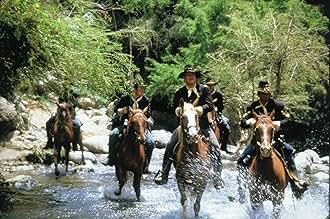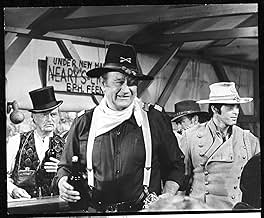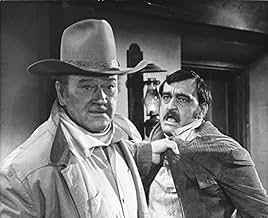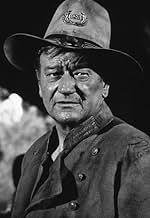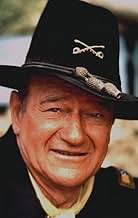IMDb रेटिंग
6.7/10
14 हज़ार
आपकी रेटिंग
गृहयुद्ध के बाद, कॉर्ड मैकनेली दो गद्दारों की खोज करता है।गृहयुद्ध के बाद, कॉर्ड मैकनेली दो गद्दारों की खोज करता है।गृहयुद्ध के बाद, कॉर्ड मैकनेली दो गद्दारों की खोज करता है।
कहानी
क्या आपको पता है
- ट्रिवियाRobert Mitchum visited his son Christopher Mitchum during filming. Director Howard Hawks asked the elder Mitchum to reprise his El Dorado (1966) role as a drunken sheriff, but Mitchum claimed he was now retired. John Wayne responded, "Mitch has been retiring ever since the first day I met him."
- गूफ़When uncoupling the train from the locomotive the rebels pull up on a lever opening the knuckle coupler and releasing the car. At the time of the Civil War railroads used a link and pin coupling system. The knuckle coupler was invented by Eli Janney in 1873, eight years after the civil war ended. They are still in use today.
- भाव
Cord McNally: Do you think you could sneak up on the fella at the gate?
Phillips: I could sneak up on a *coyote* if I've a mind to!
Cord McNally: Did you get that fella at the gate?
Phillips: He's at *another* gate now, lookin' fer *Saint Peter*!
- कनेक्शनFeatured in Plimpton! Shoot-Out at Rio Lobo (1970)
फीचर्ड रिव्यू
When I decided to write a review of Rio Lobo, I had every expectation of visiting the website and finding that the movie's weighted average was a 2.5. I was pleasantly surprised to see that it's a 7.5, and that's actually a half-point higher than my own score. To cut to the chase: I liked Rio Lobo.
It was fashionable in 1970 to trash Rio Lobo because (a) it was the supposedly feeble, last effort of a great director, Howard Hawks, who had supposedly lost interest in the picture; (b) it was too derivative of Rio Bravo and El Dorado; (c) the Duke was too old to play the part of a cavalry colonel (to say nothing of being too big; the average cavalryman in the Civil War was 5'7" and 135 lbs.); (d) the supporting cast was pathetic; (e) the production values were poor; and (f) the movie paled in comparison to Little Big Man, which was released at the same time. Much of the criticism was true. But, it was fun to watch, anyway.
Ford had his cavalry trilogy, and Hawks had his Rio trilogy, and the Duke was in all six of them. The Ford set is a cut above the Hawks set, but all six films are worth watching. Ford was working with Wayne (1947-50) at a time when Wayne's acting ability was still very much in question. And Ford succeeded on every level, especially in She Wore a Yellow Ribbon, where the character development of Capt. Nathan Brittles (Wayne) is nothing but sheer genius. Hawks, on the other hand, had (by 1959, in Rio Bravo) a very established star, and was thereby free to dwell more on story telling than he was on character development. Besides, with those amazing exteriors, the cinemagography alone was worth the cost of admission to all six pictures.
The Duke was too old to play a romantic lead in this picture (but so was Cary Grant in his last picture, Walk, Don't Run, when he, too, was about 63 years-old.) The fact that he was not a "threat" to O'Neill's character (in those pre-Viagra days) was nothing more than an extension of the persona the Duke captured the year before in True Grit, and would continue to build on in such films as The Cowboys and The Shootist. Let's face it: Wayne was becoming a likeable old coot.
Hawks was, according to reports, disappointed in Jennifer O'Neill, and by the last reel, her part has been cut in favor of Sherry Lansing's part. (Hawks did the same thing to John Ireland's part in Red River, 30 years earlier.) Actually, O'Neill didn't do THAT bad. My problem with her is that she couldn't decide whether she would play her part as the New York high-fashion model that she was, or as Kim Darby reprising her role in True Grit. At times, O'Neill's semi-imitation of Darby gets on one's nerves.
And, Hawks was rightfully disappointed in the desultory performances of the supporting cast, with the exception of Lansing and Jack Elam. The Confederate cavalry captain: He might as well have been created by computer graphics, for all the vitality he brings to the role. But, take a look at the stock players, including Hank Worden ("Old Mose" in The Searchers) and Jim Davis (Jock Ewing of Dallas fame). These are virtually cameos, if not walk-on parts, but they are effective.
I do not think Hawks gave up on this film, at least, not to the extent that people have claimed. Yakima Canutt ably handled the second unit, and the train hijacking he directed (with Hawks' help) was unusual and exciting; the cinematography, but for the occasional lighting or filtering error, was acceptable; and the editing was fairly crisp. The interior sets were shabby, that is true.
But what carries the picture is the wonderful dialogue, and Wayne. The dialogue is "pure Hawks": spare, unambiguous, natural, and realistic. Wayne's onscreen personal is so great, and his presence so magnificent, that all of the films shortcomings are rendered irrelevant.
Thank you, Mr. Hawks. Well done.
It was fashionable in 1970 to trash Rio Lobo because (a) it was the supposedly feeble, last effort of a great director, Howard Hawks, who had supposedly lost interest in the picture; (b) it was too derivative of Rio Bravo and El Dorado; (c) the Duke was too old to play the part of a cavalry colonel (to say nothing of being too big; the average cavalryman in the Civil War was 5'7" and 135 lbs.); (d) the supporting cast was pathetic; (e) the production values were poor; and (f) the movie paled in comparison to Little Big Man, which was released at the same time. Much of the criticism was true. But, it was fun to watch, anyway.
Ford had his cavalry trilogy, and Hawks had his Rio trilogy, and the Duke was in all six of them. The Ford set is a cut above the Hawks set, but all six films are worth watching. Ford was working with Wayne (1947-50) at a time when Wayne's acting ability was still very much in question. And Ford succeeded on every level, especially in She Wore a Yellow Ribbon, where the character development of Capt. Nathan Brittles (Wayne) is nothing but sheer genius. Hawks, on the other hand, had (by 1959, in Rio Bravo) a very established star, and was thereby free to dwell more on story telling than he was on character development. Besides, with those amazing exteriors, the cinemagography alone was worth the cost of admission to all six pictures.
The Duke was too old to play a romantic lead in this picture (but so was Cary Grant in his last picture, Walk, Don't Run, when he, too, was about 63 years-old.) The fact that he was not a "threat" to O'Neill's character (in those pre-Viagra days) was nothing more than an extension of the persona the Duke captured the year before in True Grit, and would continue to build on in such films as The Cowboys and The Shootist. Let's face it: Wayne was becoming a likeable old coot.
Hawks was, according to reports, disappointed in Jennifer O'Neill, and by the last reel, her part has been cut in favor of Sherry Lansing's part. (Hawks did the same thing to John Ireland's part in Red River, 30 years earlier.) Actually, O'Neill didn't do THAT bad. My problem with her is that she couldn't decide whether she would play her part as the New York high-fashion model that she was, or as Kim Darby reprising her role in True Grit. At times, O'Neill's semi-imitation of Darby gets on one's nerves.
And, Hawks was rightfully disappointed in the desultory performances of the supporting cast, with the exception of Lansing and Jack Elam. The Confederate cavalry captain: He might as well have been created by computer graphics, for all the vitality he brings to the role. But, take a look at the stock players, including Hank Worden ("Old Mose" in The Searchers) and Jim Davis (Jock Ewing of Dallas fame). These are virtually cameos, if not walk-on parts, but they are effective.
I do not think Hawks gave up on this film, at least, not to the extent that people have claimed. Yakima Canutt ably handled the second unit, and the train hijacking he directed (with Hawks' help) was unusual and exciting; the cinematography, but for the occasional lighting or filtering error, was acceptable; and the editing was fairly crisp. The interior sets were shabby, that is true.
But what carries the picture is the wonderful dialogue, and Wayne. The dialogue is "pure Hawks": spare, unambiguous, natural, and realistic. Wayne's onscreen personal is so great, and his presence so magnificent, that all of the films shortcomings are rendered irrelevant.
Thank you, Mr. Hawks. Well done.
टॉप पसंद
रेटिंग देने के लिए साइन-इन करें और वैयक्तिकृत सुझावों के लिए वॉचलिस्ट करें
- How long is Rio Lobo?Alexa द्वारा संचालित
विवरण
- रिलीज़ की तारीख़
- कंट्री ऑफ़ ओरिजिन
- भाषाएं
- इस रूप में भी जाना जाता है
- Ріо Лобо
- फ़िल्माने की जगहें
- उत्पादन कंपनियां
- IMDbPro पर और कंपनी क्रेडिट देखें
बॉक्स ऑफ़िस
- बजट
- $40,00,000(अनुमानित)
इस पेज में योगदान दें
किसी बदलाव का सुझाव दें या अनुपलब्ध कॉन्टेंट जोड़ें



